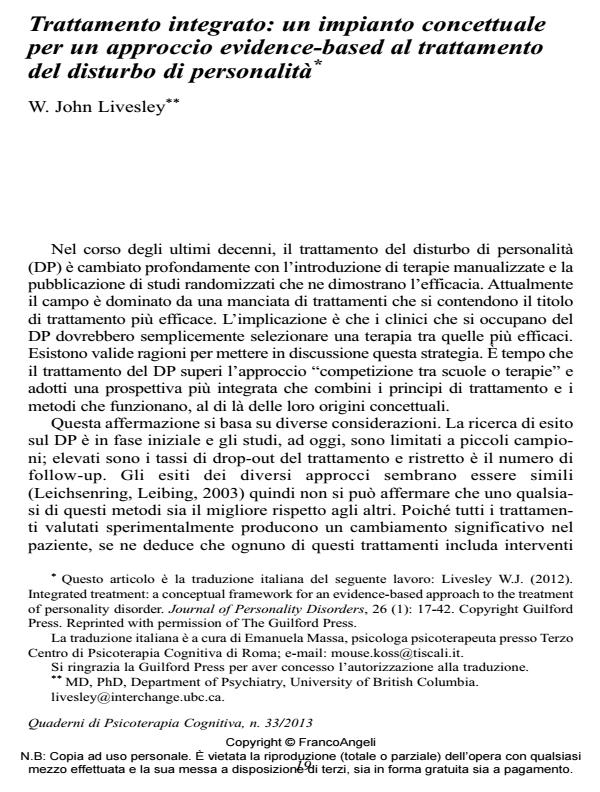Trattamento integrato: un impianto concettuale per un approccio evidence-based al trattamento del disturbo di personalità
Titolo Rivista QUADERNI DI PSICOTERAPIA COGNITIVA
Autori/Curatori W. John Livesley
Anno di pubblicazione 2013 Fascicolo 2013/33
Lingua Italiano Numero pagine 33 P. 19-51 Dimensione file 199 KB
DOI 10.3280/QPC2013-033003
Il DOI è il codice a barre della proprietà intellettuale: per saperne di più
clicca qui
Qui sotto puoi vedere in anteprima la prima pagina di questo articolo.
Se questo articolo ti interessa, lo puoi acquistare (e scaricare in formato pdf) seguendo le facili indicazioni per acquistare il download credit. Acquista Download Credits per scaricare questo Articolo in formato PDF

FrancoAngeli è membro della Publishers International Linking Association, Inc (PILA)associazione indipendente e non profit per facilitare (attraverso i servizi tecnologici implementati da CrossRef.org) l’accesso degli studiosi ai contenuti digitali nelle pubblicazioni professionali e scientifiche
L’evidenza che vi siano diverse terapie efficaci nel trattare il disturbo di personalità e che gli esiti tra i trattamenti sostanzialmente, non differiscano, suggerisce di sostituire le preoccupazioni sull’efficacia terapeutica di specifiche terapie e su quale forma di terapia usare, con un approccio evidence-based che combini i metodi che funzionano di tutte le terapie. Viene proposta una struttura concettuale per selezionare ed integrare metodi di trattamento eterogenei e organizzarli in modo coordinato. La struttura è costituita da due elementi principali: 1) un metodo per concettualizzare il disturbo di personalità sulla base di conoscenze empiriche inerenti la struttura, l’eziologia, lo sviluppo e la stabilità della patologia di personalità, da usare come guida per selezionare gli interventi e pianificare la sequenza in cui saranno usati; 2) un modello di cambiamento terapeutico basato sull’analisi della letteratura generale dei risultati della psicoterapia e studi specifici sui trattamenti del disturbo di personalità. Questa struttura prevede che il trattamento integrato sia organizzato intorno a dei principi generali di cambiamento condivisi da tutte le terapie efficaci e integrato con metodi di trattamento più specifici, provenienti dai diversi approcci e che, di volta in volta, possono essere adattati in funzione delle esigenze di trattamento di casi individuali, per particolari problemi o psicopatologie. La distribuzione organizzata di un insieme così eterogeneo di interventi può essere realizzata tramite l’impiego di uno schema delle fasi di trattamento che propone di trattare una specifica sintomatologia e le relative problematiche, secondo una via sistematica e metodica che tenga conto della loro stabilità e del potenziale di cambiamento.
W. John Livesley, Trattamento integrato: un impianto concettuale per un approccio evidence-based al trattamento del disturbo di personalità in "QUADERNI DI PSICOTERAPIA COGNITIVA" 33/2013, pp 19-51, DOI: 10.3280/QPC2013-033003